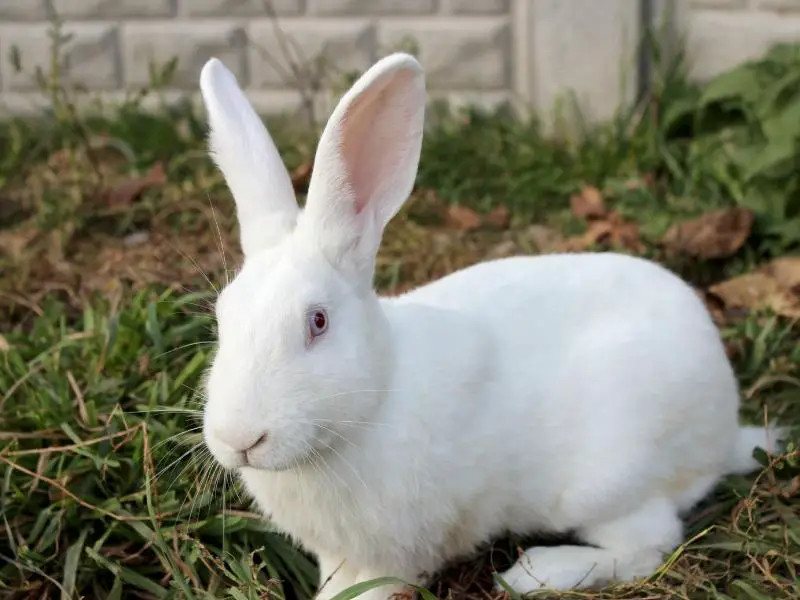Bringing home a cute little fluffy bunny is always fun and exciting. As the months roll by, you adjust their food and their exercise routines accordingly. Suddenly, they are 6 months old, and they’ve grown really quickly. You start wondering if their living space and the amount of food they are receiving is enough.
But how big do rabbits get?
Large breed rabbits (such as the Flemish Giant) can weigh over 20 pounds. An average-sized domesticated adult rabbit (such as the French Lop) can weigh about 6 pounds. Mini and dwarf rabbits (such as the Mini Rex) only weigh around 4 pounds.
If you are interested in learning more about how big rabbits can get and how big your rabbit will get, this guide has all the information you need.
What Is the Average Size of a Rabbit?
Every rabbit is unique, and just like humans, they come in different sizes and shapes depending on their breed and their age.
The average length of an adult rabbit is about 16 inches, and they weigh around 6 pounds.
Here’s a closer look at the average size of different rabbit breeds:
The Average Size of Small Rabbit Breeds
Small rabbits, also known as dwarf or mini rabbits, are rabbits that generally don’t exceed a weight of 5 pounds. These rabbits typically have a weight range of between 1.5 to 3 pounds.
The biggest dwarf rabbit is the Dwarf Lop rabbit which weighs 5 pounds.
Here’s a list of a few of the different small rabbit breeds:
- Dwarf Lionhead rabbit – under 3.75 pounds
- Dwarf Hotot rabbit – under 3 pounds
- Columbia Basin Pygmy rabbit – under 1 pound
The Average Size of Medium Rabbit Breeds
Medium rabbit breeds are the most common breed of rabbits. They can weigh anything from 5 to 8 pounds once they are fully grown.
Here’s a list of some of the different medium rabbit breeds:
- Rex rabbits – 10.5 pounds
- Satin Angora rabbits – 9.5 pounds
- English Spot rabbits – 8 pounds
The Average Size of Large Rabbit Breeds
Large or giant breeds of rabbits are not commonly seen as pets because of their large size, and they are used more for their meat.
These bunnies can weigh anything from 8 to 20 pounds and grow as tall as a small dog (when standing upright).
Here’s a look at some of the different large rabbit breeds:
- Flemish Giant – 20 pounds
- Checkered Giant – 11 pounds
- Silver Fox – 12 pounds
Factors That Affect Rabbit Size

Let’s take a closer look at some of the factors that affect the size of rabbits:
Breed
Even though each rabbit is unique, knowing the breed of your rabbit will help you estimate how big your rabbit will get.
Each breed has a different average weight and length. For example, one of the smallest miniature breeds of rabbits is the Britannia Petite.
This bunny only weighs about 2.5 pounds and has a petite body shape, whereas the English Angora rabbit can weigh between 5 to 6 pounds.
Flemish Giant rabbits can easily weigh about 20 pounds, so the breed of your bun is a huge factor affecting the size of your rabbit.
What Is the Largest Breed of Rabbit?
The largest bunny breed is the Flemish Giant. These rabbits can weigh an average of 15 to 20 pounds. They have a stocky build and a short fur coat.
A Continental Giant rabbit named Darius currently holds the Guinness World Record for being the largest rabbit in the world.
This giant rabbit has a length of 4 feet and 3 inches, with a weight of 49 pounds.
Environment
Another factor that affects the size of your bunny is the size of its environment.
Bigger bunnies require more space to grow comfortably. The size of the hutch must be correct so that your bun can exercise, preventing obesity.
Nutrition
A healthy and nutritious diet is essential for your bun. Rabbits do suffer from obesity due to the wrong nutrition, overeating, and lack of exercise.
A sure way to check if your bun is growing correctly is to run your fingertips along the sides of your bunny.
There should be a thin layer of fat covering their ribs. If you are unable to feel your bun’s ribs, there is a chance your bun may be overweight.
Your bun’s nutrition is a factor that will affect its size.
Your bun requires a balanced diet consisting of:
- Dark leafy greens, such as bok choy, romaine lettuce, and carrot tops
- Hay, such as Timothy hay
- Good-quality pellets
- Fresh fruit such as apples, bananas, and berries
Age
Age is also a factor that affects your floppy-eared friend’s size.
Here’s a look at the different sizes based on the age of your bun:
- When your bun is 4 months old, it will be about half the size of a fully grown rabbit
- When your bun is between 6 to 8 months, your bun will be about two-thirds of a fully grown rabbits size
- When your bun is 1 year old, it should typically be their full size
How to Know How Big Your Rabbit Will Get
When choosing a baby bunny, you may wonder how big your bun will grow.
Luckily, there are a few ways to help you estimate how big your bun will grow:
- If you are able to look at the parents of your bun, you will have some indication of how big your bun can get (research the breed and refer to a size guide)
- Your bun’s age will also give you some idea of how big your bun will get
- Weigh your bun every month, and cross-reference their weight with the rabbit’s breed on a size guide. This will also help you see if your bun is over or underweight
My Last Bunny Thoughts
Your floppy-eared domestic rabbit is a fantastic animal, and they come in many different shapes and sizes. It’s so important to ensure you research the breed of rabbit you have, as different sizes of rabbits may require different things.
Bigger rabbits require larger living environments and more food and water than smaller breeds.
Giant breeds may be as big as a small dogs, but they require plenty of attention and their diet needs to be adjusted accordingly.
Dwarf bunnies may be cute and tiny, but they often don’t enjoy being picked up or cuddled, and their little bones are fragile. All rabbits, big and small, make wonderful pets regardless of their size.
Related Articles:

